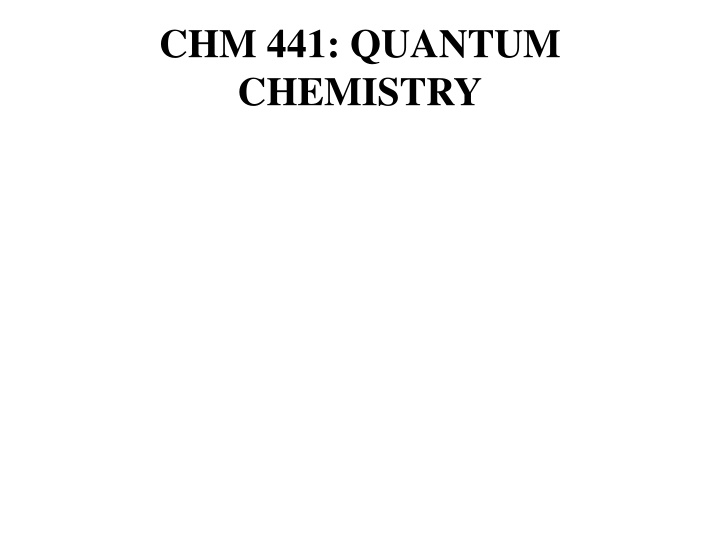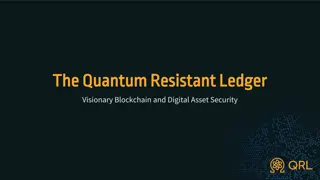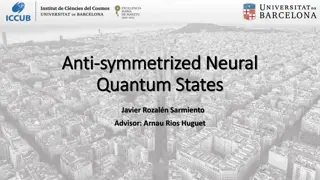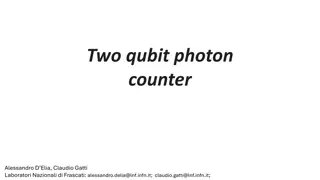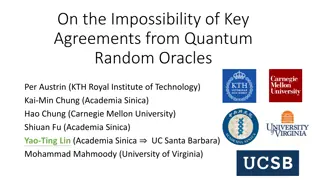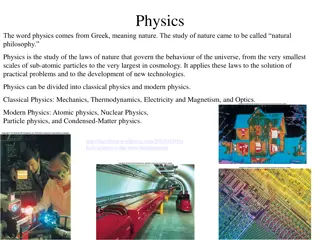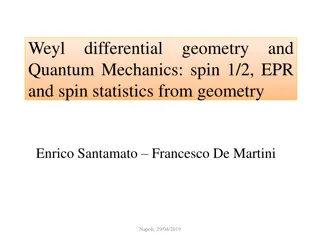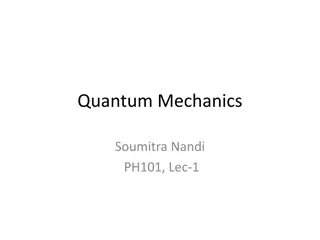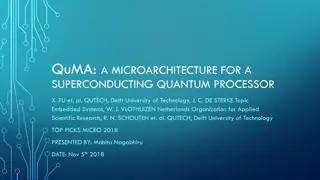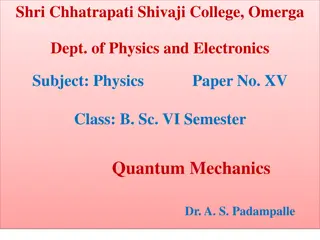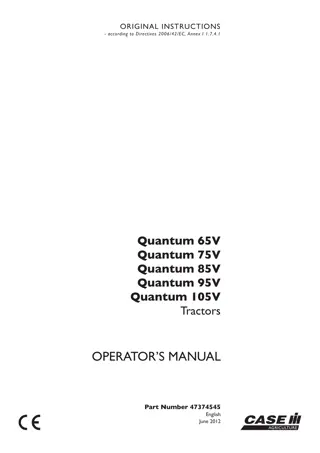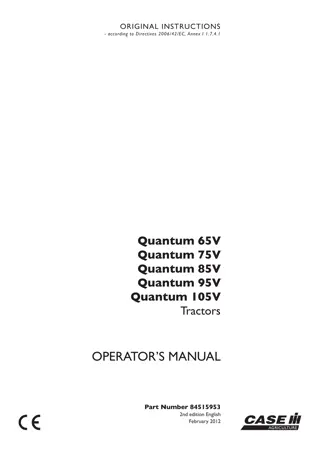Unraveling Quantum Mechanics in Chemistry
The evolution of quantum chemistry, from experimental observations challenging classical physics to the development of quantum mechanics, explains phenomena like quantization of energy and the wave-particle duality of matter. Scholars like Planck and Einstein played pivotal roles in reshaping our understanding of the microscopic world.
Download Presentation

Please find below an Image/Link to download the presentation.
The content on the website is provided AS IS for your information and personal use only. It may not be sold, licensed, or shared on other websites without obtaining consent from the author.If you encounter any issues during the download, it is possible that the publisher has removed the file from their server.
You are allowed to download the files provided on this website for personal or commercial use, subject to the condition that they are used lawfully. All files are the property of their respective owners.
The content on the website is provided AS IS for your information and personal use only. It may not be sold, licensed, or shared on other websites without obtaining consent from the author.
E N D
Presentation Transcript
CHM 441: QUANTUM CHEMISTRY
experimental observations were made that could not be reconciled or explained by the laws of classical physics. E.g. Plank measured the emission of radiation from a hot mass (called blackbody radiation) and found that it did not fit the formula derivation from classical physics. To derive the right equation, he had to assume in contrast to classical physics ideas that radiation of frequency ( ) is absorbed and emitted only in multiples of h
classical ideas. Einstein in 1905 explained this by suggesting that light of frequency ( ) consists of quanta of energy h , called Photons. When one Photon strikes an electron in the metal, the electron is ejected with a kinetic energy that is, the difference between the energy of the photon and the minimum energy needed to eject the electron.
tiny nucleus with the electrons surrounding it, but this could not be understood using classical mechanics which predicted that the electrons would radiates energy and fall into the nucleus.
quantization of angular momentum which marks the beginning of quantum mechanics applied to atoms, but was unable to describe atoms with more than one electron.
properties that are both wavelike and particle-like. Experiments showing the interference of light must be explained with wave theory whereas that of photoelectric effect reveals particlelike principles.
unknown. This is the new mechanics called quantum mechanics, It challenged classical mechanics which states that the position and momentum of a particle can be calculated precisely at all times from knowledge of the forces on the particle. Photons which have energies given by E = h are usual particles in that they have zero rest mass and travel with the speed of light. However, Einstein suggested that photons have a relative mass given by
E = mc2 = hv = hc/or E = mc2 = P = hc/ ...................................................[1]
suggested that the momentum of a particle with finite rest mass is given by mv = P = h / or = h /p = h /mv................................. [2]
V= velocity and V = P /m........................................................... .............. [3]
Equation [2] shows that all particles have a wavelike property with wavelength that is inversely proportional to the momentum.
the product of elementary charge (e) and potential difference in Joules and the energy of an electron of mass (m) moving with a velocity v well below the velocity of light is given by
E = ()mv2 = P2/2m..................................................... .........................................[4]
The total energy E of a particle is equal to the sum of its kinetics energy (( )mv2) and its potential energy V.
E = ()mv2 + V = P2/2m +V ............................................................... ...................(5)
The Heisenberg uncertainty principle
simultaneously with arbitrarily high precision in mechanics. Examples of pairs of observables that are restricted in this way are momentum and position, and energy and time; such pairs are referred to as complementary .
Heisenberg uncertainty principle can be derived by combining the de Broglie relation P = h/ and the Einstein relation E = h with properties of all waves.
The de Broglie wave for a particle is made up of a super position of an infinitely large number of waves of the form
= A sin 2(kx t).......................................................... ........ (6)
one spatial dimension for simplicity. The waves that are added together have infinitesimal different wavelengths. This superposition of waves produces a wave packed as shown below:
By the use of Fourier integral methods, it is possible to show that for wave motion of any type
xk= x1/ 1/4 ........................................................ ............. (7)
And t 1/4 ............................................................... ............. (8)
packed in space, kis the range in reciprocal wavelength, vis the range in frequency, and tis a measure of the time required for the packed to pass a given point.
values; there is a limit to the accuracy with which we can measure the wavelength. If a wave packed is of short duration, there is a limit to the accuracy with which we can measure the frequency.
uncertainty principle may be by substitution the de Broglie relation in equation [7]. Since 1/ =Px/h for motion i x direction, then by substitution,
x Px/h 1/4 ........................................................ ..................... (9)
And Px h/4 x.................................................... ................... (10)
x Px = /2.......................................................... ..................... (11)
electron would inevitably be after in the process. This would definitely limit our ability to measure the momentum. If we use a photon of shorter wavelength to determine the position of the electron more accurately, the disturbance of the momentum is greater and px is greater according to equation [11]. This same uncertainty applies to y py and z pz.
Another form of the Heisenberg uncertainty principle may be derived by substituting E = hr in equation [8].
t E/h 1/4 ................................................................................. ........... [12]
tE /2....................................................................................... ............ [13]
The time independent Schrdinger equation is written as:
-(h2/82m)(d2/dx2+ d2/dy2+ d2/dz2) (x,y,z)+ V(x,y,z) (x,y,z)= E (x,y,z)
Or where = wave function in three dimention............................................... (14)
-(h2/82m) 2 (x,y,z)+ V(x,y,z)(x,y,z)= E (x,y,z)............................................. (15)
2= del square = (d2/dx2+ d2/dy2+ d2/dz2)
